Wenbo Ding
Team Xiaomi EV-AD VLA: Learning to Navigate Socially Through Proactive Risk Perception - Technical Report for IROS 2025 RoboSense Challenge Social Navigation Track
Oct 09, 2025Abstract:In this report, we describe the technical details of our submission to the IROS 2025 RoboSense Challenge Social Navigation Track. This track focuses on developing RGBD-based perception and navigation systems that enable autonomous agents to navigate safely, efficiently, and socially compliantly in dynamic human-populated indoor environments. The challenge requires agents to operate from an egocentric perspective using only onboard sensors including RGB-D observations and odometry, without access to global maps or privileged information, while maintaining social norm compliance such as safe distances and collision avoidance. Building upon the Falcon model, we introduce a Proactive Risk Perception Module to enhance social navigation performance. Our approach augments Falcon with collision risk understanding that learns to predict distance-based collision risk scores for surrounding humans, which enables the agent to develop more robust spatial awareness and proactive collision avoidance behaviors. The evaluation on the Social-HM3D benchmark demonstrates that our method improves the agent's ability to maintain personal space compliance while navigating toward goals in crowded indoor scenes with dynamic human agents, achieving 2nd place among 16 participating teams in the challenge.
Learning More with Less: A Dynamic Dual-Level Down-Sampling Framework for Efficient Policy Optimization
Sep 26, 2025Abstract:Critic-free methods like GRPO reduce memory demands by estimating advantages from multiple rollouts but tend to converge slowly, as critical learning signals are diluted by an abundance of uninformative samples and tokens. To tackle this challenge, we propose the \textbf{Dynamic Dual-Level Down-Sampling (D$^3$S)} framework that prioritizes the most informative samples and tokens across groups to improve the efficient of policy optimization. D$^3$S operates along two levels: (1) the sample-level, which selects a subset of rollouts to maximize advantage variance ($\text{Var}(A)$). We theoretically proven that this selection is positively correlated with the upper bound of the policy gradient norms, yielding higher policy gradients. (2) the token-level, which prioritizes tokens with a high product of advantage magnitude and policy entropy ($|A_{i,t}|\times H_{i,t}$), focusing updates on tokens where the policy is both uncertain and impactful. Moreover, to prevent overfitting to high-signal data, D$^3$S employs a dynamic down-sampling schedule inspired by curriculum learning. This schedule starts with aggressive down-sampling to accelerate early learning and gradually relaxes to promote robust generalization. Extensive experiments on Qwen2.5 and Llama3.1 demonstrate that integrating D$^3$S into advanced RL algorithms achieves state-of-the-art performance and generalization while requiring \textit{fewer} samples and tokens across diverse reasoning benchmarks. Our code is added in the supplementary materials and will be made publicly available.
MoiréTac: A Dual-Mode Visuotactile Sensor for Multidimensional Perception Using Moiré Pattern Amplification
Sep 16, 2025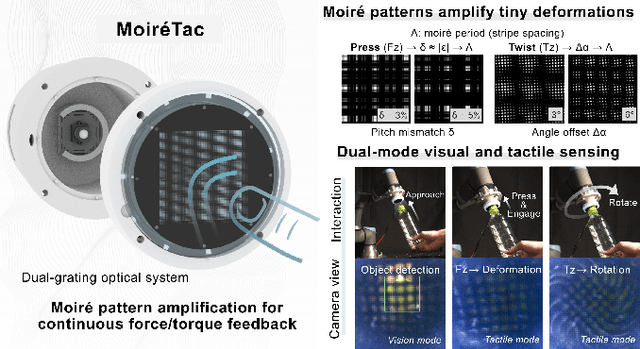
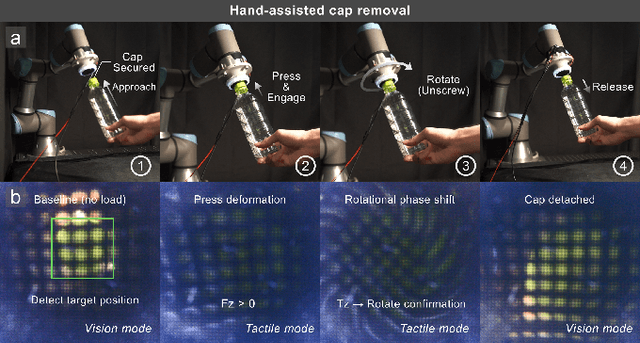
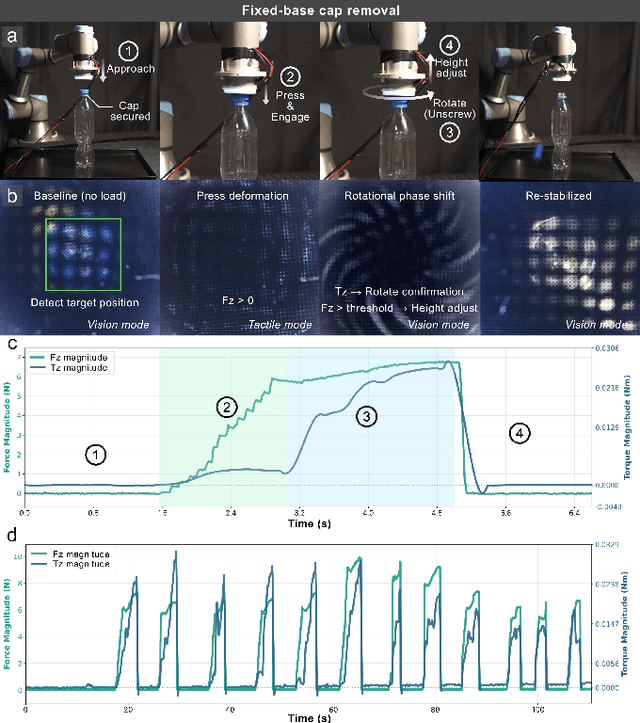

Abstract:Visuotactile sensors typically employ sparse marker arrays that limit spatial resolution and lack clear analytical force-to-image relationships. To solve this problem, we present \textbf{Moir\'eTac}, a dual-mode sensor that generates dense interference patterns via overlapping micro-gratings within a transparent architecture. When two gratings overlap with misalignment, they create moir\'e patterns that amplify microscopic deformations. The design preserves optical clarity for vision tasks while producing continuous moir\'e fields for tactile sensing, enabling simultaneous 6-axis force/torque measurement, contact localization, and visual perception. We combine physics-based features (brightness, phase gradient, orientation, and period) from moir\'e patterns with deep spatial features. These are mapped to 6-axis force/torque measurements, enabling interpretable regression through end-to-end learning. Experimental results demonstrate three capabilities: force/torque measurement with R^2 > 0.98 across tested axes; sensitivity tuning through geometric parameters (threefold gain adjustment); and vision functionality for object classification despite moir\'e overlay. Finally, we integrate the sensor into a robotic arm for cap removal with coordinated force and torque control, validating its potential for dexterous manipulation.
UltraTac: Integrated Ultrasound-Augmented Visuotactile Sensor for Enhanced Robotic Perception
Aug 29, 2025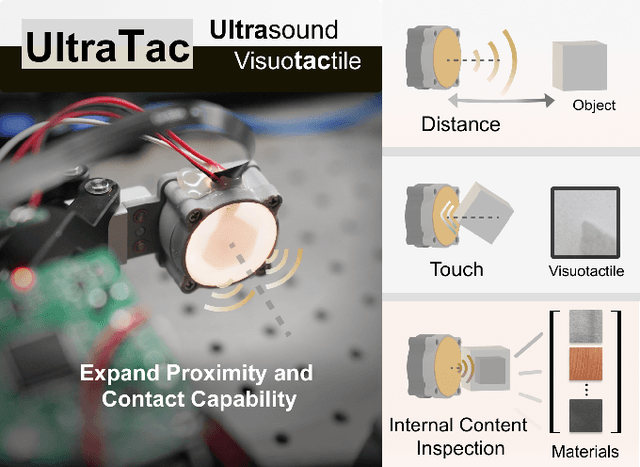
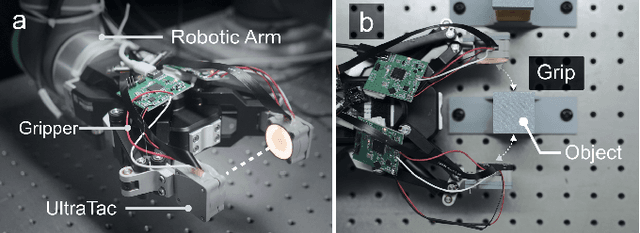

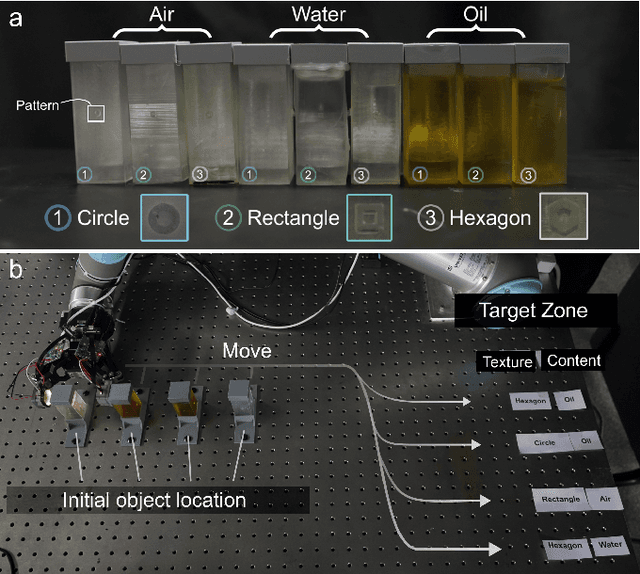
Abstract:Visuotactile sensors provide high-resolution tactile information but are incapable of perceiving the material features of objects. We present UltraTac, an integrated sensor that combines visuotactile imaging with ultrasound sensing through a coaxial optoacoustic architecture. The design shares structural components and achieves consistent sensing regions for both modalities. Additionally, we incorporate acoustic matching into the traditional visuotactile sensor structure, enabling integration of the ultrasound sensing modality without compromising visuotactile performance. Through tactile feedback, we dynamically adjust the operating state of the ultrasound module to achieve flexible functional coordination. Systematic experiments demonstrate three key capabilities: proximity sensing in the 3-8 cm range ($R^2=0.90$), material classification (average accuracy: 99.20%), and texture-material dual-mode object recognition achieving 92.11% accuracy on a 15-class task. Finally, we integrate the sensor into a robotic manipulation system to concurrently detect container surface patterns and internal content, which verifies its potential for advanced human-machine interaction and precise robotic manipulation.
$NavA^3$: Understanding Any Instruction, Navigating Anywhere, Finding Anything
Aug 06, 2025
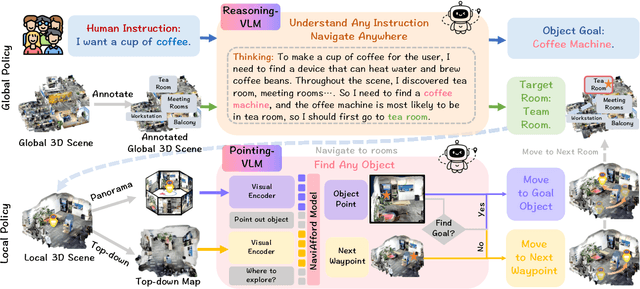


Abstract:Embodied navigation is a fundamental capability of embodied intelligence, enabling robots to move and interact within physical environments. However, existing navigation tasks primarily focus on predefined object navigation or instruction following, which significantly differs from human needs in real-world scenarios involving complex, open-ended scenes. To bridge this gap, we introduce a challenging long-horizon navigation task that requires understanding high-level human instructions and performing spatial-aware object navigation in real-world environments. Existing embodied navigation methods struggle with such tasks due to their limitations in comprehending high-level human instructions and localizing objects with an open vocabulary. In this paper, we propose $NavA^3$, a hierarchical framework divided into two stages: global and local policies. In the global policy, we leverage the reasoning capabilities of Reasoning-VLM to parse high-level human instructions and integrate them with global 3D scene views. This allows us to reason and navigate to regions most likely to contain the goal object. In the local policy, we have collected a dataset of 1.0 million samples of spatial-aware object affordances to train the NaviAfford model (PointingVLM), which provides robust open-vocabulary object localization and spatial awareness for precise goal identification and navigation in complex environments. Extensive experiments demonstrate that $NavA^3$ achieves SOTA results in navigation performance and can successfully complete longhorizon navigation tasks across different robot embodiments in real-world settings, paving the way for universal embodied navigation. The dataset and code will be made available. Project website: https://NavigationA3.github.io/.
ManiGaussian++: General Robotic Bimanual Manipulation with Hierarchical Gaussian World Model
Jun 24, 2025Abstract:Multi-task robotic bimanual manipulation is becoming increasingly popular as it enables sophisticated tasks that require diverse dual-arm collaboration patterns. Compared to unimanual manipulation, bimanual tasks pose challenges to understanding the multi-body spatiotemporal dynamics. An existing method ManiGaussian pioneers encoding the spatiotemporal dynamics into the visual representation via Gaussian world model for single-arm settings, which ignores the interaction of multiple embodiments for dual-arm systems with significant performance drop. In this paper, we propose ManiGaussian++, an extension of ManiGaussian framework that improves multi-task bimanual manipulation by digesting multi-body scene dynamics through a hierarchical Gaussian world model. To be specific, we first generate task-oriented Gaussian Splatting from intermediate visual features, which aims to differentiate acting and stabilizing arms for multi-body spatiotemporal dynamics modeling. We then build a hierarchical Gaussian world model with the leader-follower architecture, where the multi-body spatiotemporal dynamics is mined for intermediate visual representation via future scene prediction. The leader predicts Gaussian Splatting deformation caused by motions of the stabilizing arm, through which the follower generates the physical consequences resulted from the movement of the acting arm. As a result, our method significantly outperforms the current state-of-the-art bimanual manipulation techniques by an improvement of 20.2% in 10 simulated tasks, and achieves 60% success rate on average in 9 challenging real-world tasks. Our code is available at https://github.com/April-Yz/ManiGaussian_Bimanual.
MMWiLoc: A Multi-Sensor Dataset and Robust Device-Free Localization Method Using Commercial Off-The-Shelf Millimeter Wave Wi-Fi Devices
Jun 13, 2025Abstract:Device-free Wi-Fi sensing has numerous benefits in practical settings, as it eliminates the requirement for dedicated sensing devices and can be accomplished using current low-cost Wi-Fi devices. With the development of Wi-Fi standards, millimeter wave Wi-Fi devices with 60GHz operating frequency and up to 4GHz bandwidth have become commercially available. Although millimeter wave Wi-Fi presents great promise for Device-Free Wi-Fi sensing with increased bandwidth and beam-forming ability, there still lacks a method for localization using millimeter wave Wi-Fi. Here, we present two major contributions: First, we provide a comprehensive multi-sensor dataset that synchronously captures human movement data from millimeter wave Wi-Fi, 2.4GHz Wi-Fi, and millimeter wave radar sensors. This dataset enables direct performance comparisons across different sensing modalities and facilitates reproducible researches in indoor localization. Second, we introduce MMWiLoc, a novel localization method that achieves centimeter-level precision with low computational cost. MMWiLoc incorporates two components: beam pattern calibration using Expectation Maximization and target localization through Multi-Scale Compression Sensing. The system processes beam Signal-to-Noise Ratio (beamSNR) information from the beam-forming process to determine target Angle of Arrival (AoA), which is then fused across devices for localization. Our extensive evaluation demonstrates that MMWiLoc achieves centimeter-level precision, outperforming 2.4GHz Wi-Fi systems while maintaining competitive performance with high-precision radar systems. The dataset and examples processing code will be released after this paper is accepted at https://github.com/wowoyoho/MMWiLoc.
Universal Visuo-Tactile Video Understanding for Embodied Interaction
May 28, 2025Abstract:Tactile perception is essential for embodied agents to understand physical attributes of objects that cannot be determined through visual inspection alone. While existing approaches have made progress in visual and language modalities for physical understanding, they fail to effectively incorporate tactile information that provides crucial haptic feedback for real-world interaction. In this paper, we present VTV-LLM, the first multi-modal large language model for universal Visuo-Tactile Video (VTV) understanding that bridges the gap between tactile perception and natural language. To address the challenges of cross-sensor and cross-modal integration, we contribute VTV150K, a comprehensive dataset comprising 150,000 video frames from 100 diverse objects captured across three different tactile sensors (GelSight Mini, DIGIT, and Tac3D), annotated with four fundamental tactile attributes (hardness, protrusion, elasticity, and friction). We develop a novel three-stage training paradigm that includes VTV enhancement for robust visuo-tactile representation, VTV-text alignment for cross-modal correspondence, and text prompt finetuning for natural language generation. Our framework enables sophisticated tactile reasoning capabilities including feature assessment, comparative analysis, scenario-based decision making and so on. Experimental evaluations demonstrate that VTV-LLM achieves superior performance in tactile video understanding tasks, establishing a foundation for more intuitive human-machine interaction in tactile domains.
Mastering Multi-Drone Volleyball through Hierarchical Co-Self-Play Reinforcement Learning
May 07, 2025Abstract:In this paper, we tackle the problem of learning to play 3v3 multi-drone volleyball, a new embodied competitive task that requires both high-level strategic coordination and low-level agile control. The task is turn-based, multi-agent, and physically grounded, posing significant challenges due to its long-horizon dependencies, tight inter-agent coupling, and the underactuated dynamics of quadrotors. To address this, we propose Hierarchical Co-Self-Play (HCSP), a hierarchical reinforcement learning framework that separates centralized high-level strategic decision-making from decentralized low-level motion control. We design a three-stage population-based training pipeline to enable both strategy and skill to emerge from scratch without expert demonstrations: (I) training diverse low-level skills, (II) learning high-level strategy via self-play with fixed low-level controllers, and (III) joint fine-tuning through co-self-play. Experiments show that HCSP achieves superior performance, outperforming non-hierarchical self-play and rule-based hierarchical baselines with an average 82.9\% win rate and a 71.5\% win rate against the two-stage variant. Moreover, co-self-play leads to emergent team behaviors such as role switching and coordinated formations, demonstrating the effectiveness of our hierarchical design and training scheme.
VTire: A Bimodal Visuotactile Tire with High-Resolution Sensing Capability
Apr 27, 2025Abstract:Developing smart tires with high sensing capability is significant for improving the moving stability and environmental adaptability of wheeled robots and vehicles. However, due to the classical manufacturing design, it is always challenging for tires to infer external information precisely. To this end, this paper introduces a bimodal sensing tire, which can simultaneously capture tactile and visual data. By leveraging the emerging visuotactile techniques, the proposed smart tire can realize various functions, including terrain recognition, ground crack detection, load sensing, and tire damage detection. Besides, we optimize the material and structure of the tire to ensure its outstanding elasticity, toughness, hardness, and transparency. In terms of algorithms, a transformer-based multimodal classification algorithm, a load detection method based on finite element analysis, and a contact segmentation algorithm have been developed. Furthermore, we construct an intelligent mobile platform to validate the system's effectiveness and develop visual and tactile datasets in complex terrains. The experimental results show that our multimodal terrain sensing algorithm can achieve a classification accuracy of 99.2\%, a tire damage detection accuracy of 97\%, a 98\% success rate in object search, and the ability to withstand tire loading weights exceeding 35 kg. In addition, we open-source our algorithms, hardware, and datasets at https://sites.google.com/view/vtire.
 Add to Chrome
Add to Chrome Add to Firefox
Add to Firefox Add to Edge
Add to Edge